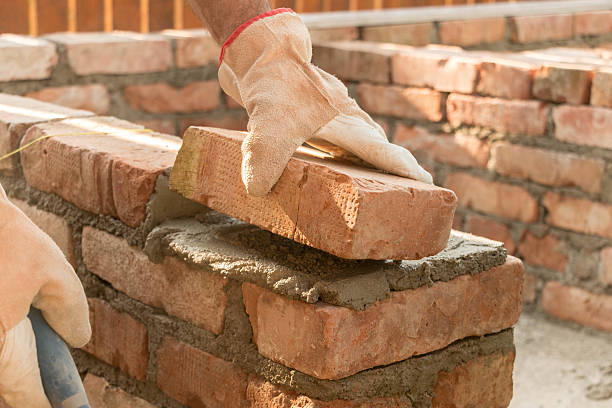Bricklayer Auckland for Beginners
Wiki Article
Our Bricklayer Auckland Diaries
Table of ContentsThe Best Guide To Bricklayer AucklandNot known Facts About Bricklayer AucklandThe Only Guide to Bricklayer AucklandThe 30-Second Trick For Bricklayer AucklandBricklayer Auckland Can Be Fun For EveryoneThe Greatest Guide To Bricklayer Auckland
Bricks should constantly be stacked on planks; never ever pile them straight on uneven or soft ground. Do not save blocks on scaffolds or runways.Other than where piled in sheds, brick stacks ought to never be greater than 7 feet high. When a heap of block gets to an elevation of 4 feet, it must be tapered back 1 inch in every foot of height over the 4-foot degree. The tops of block piles have to be kept level, and also the taper should be preserved during unpiling operations.
Structural bond refers to exactly how the specific stonework devices interlock or link together into a single structural system. You can achieve architectural bonding of block and also floor tile wall surfaces in among the following three ways: Overlapping (interlocking) the masonry units. Embedding steel incorporate attaching joints. Using cement to stick adjacent wythes of masonry.
Examine This Report about Bricklayer Auckland
Pattern bond refers to the pattern created by the masonry units as well as mortar joints on the face of a wall surface (Bricklayer Auckland). The pattern may arise from the structural bond, or it might be simply ornamental and also unassociated to the structural bond. Number 4-4 reveals the six standard pattern bonds alike usage today.The running bond is the simplest of the 6 patterns, containing all cots. Since the bond has no headers, steel ties generally create the structural bond. The running bond is made use of mainly in dental caries wall construction, block veneer wall surfaces, as well as dealing with tile walls made with added wide cot ceramic tile.
Great blocks should not break down when positioned in water. Just when fat lime or clay mortar is used or when one is compelled to make use of bricks that are not well charred, this saturating policy has to be loosened up.
Some Known Incorrect Statements About Bricklayer Auckland
In all situations, bricks must not be managed in baskets or in any various other setting which will destroy the sharpness of their sides. A layer of mortar is spread out to cover the full size of the wall surface for an appropriate length of the lower course.
Ultimately, we press the side protruding mortar in firmly to be level with the face of the wall if it is to be left unplastered. In the usual method adopted by many masons, a row of bricks is very first positioned on a slim layer of bed mortar leaving the cross joints vacant.


Strictly this is not a great technique. (However, when making use of cement mortar of high stamina, the loss go to my blog of stamina as a result of infraction of these guidelines may be only low.)The walls are increased genuinely plumb. All programs are laid absolutely horizontal and also all upright joints genuinely vertical. Vertical joints in alternate training courses ought to come straight, one over the various other.
Getting The Bricklayer Auckland To Work
For this purpose, a wooden straight side with graduation offering a density of each brick program including joint can be utilized for support. For a thick wall, the above procedure is duplicated in addition to both faces of the wall and the interior filling blocks for the thick wall are stocked a comparable manner.
This operation of loading open joints is labelled flushing-up. It is incorrectly omitted for numerous programs on some badly-executed tasks and also only done later on (not after every course) in see page an ineffective manner. It is not an excellent technique as well as should be stayed clear of as it is essential that every training course ought to be purged as much as the degree if great work is called for.

Some Of Bricklayer Auckland
The mortar rising as well as filling the upright joints totally and develops an extremely strong and also solid wall surface. This is understood as larrying. For a rat trap bond work (as in the construction of dental caries walls), if the mortar is placed thoughtlessly on the brick, a few of it will certainly fall under the tooth cavities and will be thrown away.The face of the brickwork shall likewise be cleansed of all mortar droppings, and so on(ii) When scenarios provide it required to continue a portion of a building in irregular browse around here programs, the work will be developed back (according to the bond made use of on the job) at an angle not steeper than 45 levels so regarding guarantee an uniform and efficient bonding.
Or else, for faces to be plastered, completing of the face joints ought to be performed as reviewed in below (This is very vital.)(iv) The walls ought to be consistently elevated all over not leaving any type of part one metre (3 feet) lower than the various other - Bricklayer Auckland. A day's job should not be more than 1.
Getting The Bricklayer Auckland To Work
When the facework is to be later plastered or the joints alone are to be sharp, the joints need to be raked while the wall surface is being built. Bricklayer Auckland. It needs to be raked to a minimal deepness of 12 mm by a raking device throughout the progress of the job itself, when the mortar is still environment-friendly.
If smudging or pointing is not imagined, the joints need to be struck flush as well as finished at the time of laying itself, as already specified. Half-brick wall surfaces often tend to fracture unless treatment is taken in its building. Brickwork in half-brick masonry is to be accomplished with cots in 1: 5 mortar.
Report this wiki page